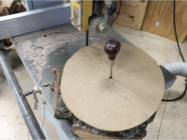I have an early 80s delta 14” bandsaw. It has a 1/2 hp motor, and the previous owner upgraded with a 6” riser, spring and tension release from Carter, and urethane tires. It has the original miter gage and fence
I have gone thru all of the tune up advice I can find. Wheels coplaner, blade riding center of both wheels. table adjusted to blade so it’s square front to back and left to right. Fence and cut line Parallel to miter slot. I’m using the Timberwolf wet wood 3/8” blade, and it’s sharp.
I can cut 12” thick green red oak in both crosscut and ripping with no problem, no drifting. Sometimes it will give a slight vibration like the blade dig in too much. I can cut down the middle or wafer thin slices perfectly.
Problem is when I am trying to cut with grain at an angle to the blade, the blade tries to wander left or right and binds up. Mostly trying to cut round blanks, when lopping off the corners.
Any ideas on what’s causing this?
I suspect a motor upgrade might help with the vibration I get, but I’m stumped on the blade wander when cutting corners off blanks.
I have gone thru all of the tune up advice I can find. Wheels coplaner, blade riding center of both wheels. table adjusted to blade so it’s square front to back and left to right. Fence and cut line Parallel to miter slot. I’m using the Timberwolf wet wood 3/8” blade, and it’s sharp.
I can cut 12” thick green red oak in both crosscut and ripping with no problem, no drifting. Sometimes it will give a slight vibration like the blade dig in too much. I can cut down the middle or wafer thin slices perfectly.
Problem is when I am trying to cut with grain at an angle to the blade, the blade tries to wander left or right and binds up. Mostly trying to cut round blanks, when lopping off the corners.
Any ideas on what’s causing this?
I suspect a motor upgrade might help with the vibration I get, but I’m stumped on the blade wander when cutting corners off blanks.

